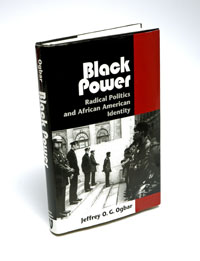New Book: Black Power Movement
Shaped African American Identity
 |
|
Jeffrey Ogbar has published a new book on the Black Power Movement. |
| Photo by Rose Lovelace |
The Black Power movement in the 1960’s was more central to the lives of African Americans than has been historically portrayed, says Jeffrey Ogbar, associate professor of history and director of the Institute for African American Studies.
“It had more lasting cultural consequences than the civil rights movement,” he says.
In his new book, Black Power: Radical Politics and African American Identity, Ogbar examines the ways in which Black Power shaped the contours of racial discourse, changed the politics of protest, and influenced other ethnic groups.
Focusing on two organizations, the Nation of Islam and the Black Panther Party, Ogbar says the book “extends the conversation about the black freedom movement beyond civil rights.
“Black Power affected African American identity and politics as much as any speech, march, or legal victory of the civil rights movement,” he writes. “It demanded inclusion while advocating autonomy and self-determination.
“Many of my students think the civil rights movement was simply about separate water fountains and separate seating on the bus,” Ogbar says. “A general textbook would reduce it to that. But that was the least of the concerns of the African Americans of that period. Martin Luther King, Roy Wilkins, Whitney Young, and other black leaders reflected the wider concerns about voting and being able to go to school. They were concerned about being murdered, tortured, and terrorized.”
Still, these black leaders “never talked about black pride,” Ogbar says. “They never uttered ‘black is beautiful’; they never advocated for African American or black studies programs. They were critical of these things. They denounced them as turning back the clock.”
 Obgar says that by 1970, the black freedom movement had eclipsed the drive for
integration that had been articulated by black leadership. “We see a fundamental
shift in how black people collectively start to see themselves in music and fashion,” he
says. “We see a celebration of blackness that was distinct from the civil
rights movement, and it textured the collective expression of African Americans
from that point on. And to this day, we find the Black Power movement’s legacy
palpable in everything.”
Obgar says that by 1970, the black freedom movement had eclipsed the drive for
integration that had been articulated by black leadership. “We see a fundamental
shift in how black people collectively start to see themselves in music and fashion,” he
says. “We see a celebration of blackness that was distinct from the civil
rights movement, and it textured the collective expression of African Americans
from that point on. And to this day, we find the Black Power movement’s legacy
palpable in everything.”
The book explains some of the informal ways in which African Americans adjusted to and resisted white supremacy. “Black Power argued that black people, who had been historically marginalized, should see themselves differently,” Ogbar says, “and that forced others to look at them differently. There was such a visible departure from the cultural mores – you couldn’t help but notice the Afros and dashikis. There was a celebration of blackness, which I argue is inextricably tied to how non-black people also view African Americans.”
Ogbar says the Black Power movement has shaped all ethnic groups. A chapter in the book, Rainbow Radicalism, is devoted to the rise of what he has coined ‘radical ethnic nationalism.’ “The Black Power movement had some of the most visible influences on the radical activist struggles of Latinos, Asians, and Native Americans,” he says, giving rise to organizations including the Brown Berets, Young Lords, and the American Indian Movement.

